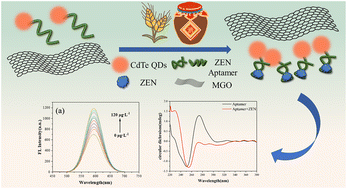A quantum dot aptamer fluorescent sensor based on magnetic graphene oxide for the detection of zearalenone
Abstract
As an estrogenic mycotoxin found in a wide range of agricultural crops, the toxicity of zearalenone (ZEN) poses a serious risk to human health. Accordingly, to achieve rapid detection of zearalenone in complex samples, an aptamer fluorescence sensor based on magnetic graphene oxide was developed. Compared with traditional methods, this technique has the virtues of simple operation, low cost, and reliable performance. Magnetic graphene oxide (MGO) was synthesized as a fluorescent bursting agent, using a chemical precipitation approach by depositing Fe3O4 on the surface of graphene oxide. As a fluorescent probe, an aptamer coupling with CdTe quantum dots and zearalenone was used. Following the specific binding of zearalenone and the aptamer, the affinity interaction between the fluorescent probe and MGO was weakened, resulting in the recovery of fluorescence and making the qualitative and quantitative analysis of zearalenone available via fluorescence intensity determination. The results indicated that the method's linear range was 5–120 μg L−1 and its detection limit was 2.9 μg L−1. In addition, the recoveries varied from 76.4 to 118.8% for crop samples, with relative standard deviations (RSDs) between 0.8 and 9.5%, which suggests an effective method for the separation and detection of mycotoxins in actual environmental samples.



 Please wait while we load your content...
Please wait while we load your content...